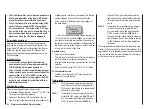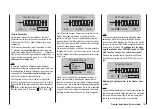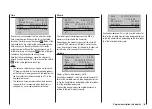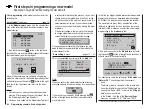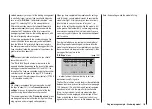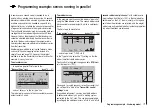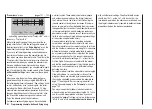
165
Programming example - fixed-wing model
of the model’s settings. As your piloting skills improve
and you gain experience, it is very likely that you will
feel the need to try out refinements such as expanded
control systems, and to cater for these requirements you
may find that the text deviates from the obvious order of
options, or that one or other of the options is mentioned
more than once.
On the other hand, it can certainly occur that not every
step described in these instructions is relevant to a
particular model, just as some users might miss the
description of a particular step which is relevant to his
model only …
Regardless of all this, it is worthwhile thinking carefully
about a sensible layout of the transmitter controls at this
point, just before you start programming the model data.
If the model in question is one with the emphasis on
“power” - whether the power of an electric motor or
internal-combustion engine (glow motor) - you will prob-
ably encounter few problems in this matter, because
the two stick units are primarily employed to control the
four basic functions “power control (= throttle)”, “rudder”,
“elevator” and “aileron”. Nevertheless, you still have to
call up the …
“Base settings” menu
mod name
stick mode
CH8 delay
motor at C1
1
yes
no
tail type
normal
GRAUBELE
… and define your preferred throttle direction, i. e.
throttle minimum forward (“Idle forward”) or back (“Idle
back”), because the program’s default setting is “none”
(i. e. no motor) when you first set up a model memory.
The basic difference between “none” or “none/inv” and
“throttle min. forward / back” is the effect of the Ch 1 trim.
The trim is effective over the full stick travel if “none (/
inv)” is entered, but it only affects the idle range if you
enter “throttle min. forward or back”. However, it also
affects the “direction of effect” of the Ch 1 stick, i. e. if
you switch from “forward” to “back” or vice versa, you
do not also have to reverse the direction of the throttle
(or brake) servo. For safety reasons you will also see a
warning message, and hear an audible warning, if you
switch the transmitter on with the throttle stick positioned
towards “full-throttle” - but only if you have already set
“throttle min. forward or back”.
#01
0:33h
stop
0:00
0:00
0.0V
5.2
HoTT
M
throttle
too
high !
Your choice of “none” (no motor) or “throttle min. forward
or back” also affects the range of mixers available in the
“
Fixed-wing mixers
” menu. The mixers “Brake
NN *”
are only present if you choose “none” (no motor) or
“none/inv”; otherwise they are suppressed.
In addition to these basic matters you will certainly need
to consider carefully how best to control any “auxiliary
functions” present on your model.
In contrast, if your model is a glider or electric glider the
whole situation may be rather different. The immediate
question is: what is the best way of operating the motor
and braking system? Now, some solutions have proved
to be practical, and others less so.
For example, it is not a good idea to be forced to let
go of one of the primary sticks in order to extend the
airbrakes or deploy the crow braking system when your
glider is on the landing approach. It surely makes more
sense to set up switchable functions for the Ch 1 stick
(see example 4 on page 172), or to assign the braking
system to the throttle stick, and shift the motor control
to a slider - or even a switch. With this type of model the
electric motor is often little more than a “self-launching
system”, and is used either to haul the model into the
sky at full power, or to pull it from one area of lift to the
next at, say half-power, and for such models a three-
position switch is usually quite adequate. If the switch is
positioned where you can easily reach it, then you can
turn the motor on and off without having to let go of the
sticks - even on the landing approach.
Incidentally, similar thinking can be applied to flap
control systems, regardless of whether they are “just”
the ailerons, or full-span (combination) control surfaces
which are raised and lowered in parallel.
Once you are satisfied that all these preparations have
been completed successfully, programming can com-
mence.
* NN = Nomen Nominandum (name to be stated)
Summary of Contents for mx-12 Hott
Page 1: ...Programming Manual 33116 mx 16 HoTT 3 en mx 16...
Page 35: ...35 For your notes...
Page 49: ...49 For your notes...
Page 55: ...55 For your notes...
Page 59: ...59 For your notes...
Page 63: ...63 For your notes...
Page 69: ...69 For your notes...
Page 91: ...91 For your notes...
Page 101: ...101 For your notes...
Page 123: ...123 For your notes...
Page 181: ...181 For your notes...
Page 193: ...193 For your notes...






